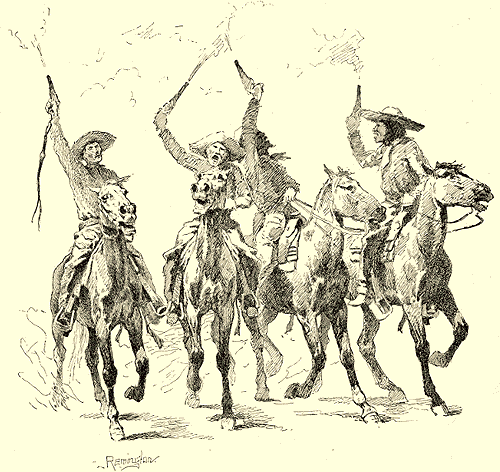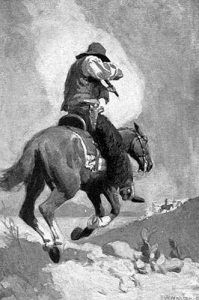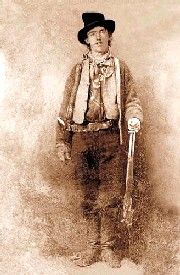The Imitation Desperado – Legends of America (original) (raw)
By Emerson Hough in 1905

Imitation Desperadoes.
As far as he has a place in literature, the counterfeit bad man was produced mainly by Western consumptives for Eastern consumption. Sometimes, he was in person manufactured in the East and sent West. It is easy to see the philosophical difference between the actual bad man of the West and the imitation article. The bad man was an evolution; the imitation bad man was an instantaneous creation, a supply arising to fill a popular demand. There arose, partly in the West and partly in the East, men who gravely and calmly proceeded to look the part. After looking the part for a time, to their satisfaction at least, and taking themselves seriously as befitted the situation, they, in many instances, faded away and disappeared in that Nowhere whence they came. Some of them took themselves too seriously for their own good. Of course, there existed for some years certain possibilities that any one of these bad men might run against the real thing.
Western manhunt by John W. Newton appeared in The Story of the Outlaw.
There always existed in the real, sober, levelheaded West a contempt for the West-struck man who was not really bad but who wanted to seem “bad.” Singularly enough, men of this type were not so frequently local products as immigrants. The “bootblack bad man” was a character recognized on the frontier — the city tough gone West with ambitions to achieve a bad eminence. Some of these men were partially bad for a while. Some of them, no doubt, even left behind them, after their sudden funerals, the impression that they had been wholly bad. You cannot detect all the counterfeit currency in the world, as severe as the test for counterfeits was in the Old West. There is, of course, no great amount of difference between the West and the East. All America, as well as the West, demanded of its citizens nothing so much as genuineness. Yet the Western phrase, to “stand the acid,” was not surpassed in graphic descriptiveness. When an imitation bad man came into a town of the old frontier, he had to “stand the acid” or get out. Someone would call his hand. “My friend,” said old Bob Bobo, the famous Mississippi bear hunter, to a man doing some pretty loud talking, “I have always noticed that when a man goes out hunting for trouble in these bottoms, he almost always finds it.” Two weeks later, this same loud talker threatened a calm man in simple jeans pants, who took a shotgun and slew him impulsively. Now, the West got its hot blood mainly from the South, and the dogma of the Southern town was the same in the Western mining town or cow camp — the bad man or the would-be bad man had to declare himself before long, and the acid bottle was always close at hand.
That there were grades in counterfeit bad men was accepted as a truth on the frontier. A man might be known as dangerous, as a murderer at heart, and yet be despised. The imitation bad man discovered that it is comparatively easy to terrify a good part of the population of a community. Sometimes, a base imitation of a desperado is exalted in the public eye as the real article. A few years ago, four misled hoodlums of Chicago held up a street-car barn, killed two men, stole a sum of money, killed a policeman and another man, and took refuge in a dugout in the sandhills below the city, comporting themselves according to the most accepted dime-novel standards. Clumsily arrested by 100 men or so, instead of being tidily killed by three or four, as would have been the case on the frontier, they were put in jail, given columns of newspaper notice, and worshiped by large crowds of maudlin individuals. These men probably died in the belief that they were “bad.” They were not bad men but imitations, counterfeit, and, indeed, nothing more than cheap and dirty little murderers.
Of course, we all can detect the mere notoriety hunter, who poses about in cheap pretentiousness, but now and then in the West, there turned up something more challenging to understand. Perhaps the most typical case of imitation bad man ever known, at least in the Southwest, was Bob Ollinger, who was killed by Billy the Kid in 1881 when the latter escaped from jail at Lincoln, New Mexico.
That Ollinger was a killer had been proved beyond the possibility of a doubt. He had no respect for human life, and those who knew him best knew that he was a murderer at heart. His reputation was gained otherwise than through the severe test of an “even break.” Some say that he killed Chavez, a Mexican, as he offered his own hand in greeting. He killed another man, Hill, in a similarly treacherous way. Later, when, as a peace officer, he was with a deputy, Pierce, serving a warrant on one Jones, he pulled his gun and, without need or provocation, shot Jones through. The same bullet, passing through Jones’s body, struck Pierce in the leg and left him crippled for life.
Billy the Kid.
Again, Ollinger was out as a deputy with a noted sheriff in pursuit of a Mexican criminal who had taken refuge in a ditch. Ollinger wanted only to get into a position where he could shoot the man. However, his superior officer crawled alone up the ditch and, rising suddenly, covered his man and ordered him to surrender. The Mexican threw down his gun and said that he would surrender to the sheriff but that he was sure Ollinger would kill him. This fear was justified.
“When I brought out the man,” said the sheriff, “Ollinger came up on the run with his cocked six-shooter in his hand. His long hair flew behind him as he ran, and I never saw so devilish a look on any human being’s face. He simply wanted to shoot that Mexican, and he chased him around me until I had to tell him I would kill him if he did not stop.” “Ollinger was a born murderer at heart,” the sheriff added later. “I never slept out with him that I did not watch him. After I had more of a reputation, I think Ollinger would have been glad to kill me for the notoriety of it. I never gave him a chance to shoot me in the back or when I was asleep. Of course, you will understand that we had to use for deputies such material as we could get.”
Ollinger was the sort of imitation desperado that looks the part. He wore his hair long and affected the ultra-Western dress, which today is despised in the West. He was one of the very few men at that time — twenty-five years ago — who carried a knife at his belt. When he was in such a town as Las Vegas or Sante Fe, he delighted to put on a buckskin shirt, spread his hair out on his shoulders, and walk through the streets, picking his teeth with his knife, or once in a while throwing it in such a way that it would stick up in a tree or aboard. He presented an eye-filling spectacle and was the ideal imitation of a bad man. This being the case, there may be interest in following out his life to its close and in noting how the bearing of the bad man’s title sometimes exacted a very high price on the claimant.
Ollinger, who had made many threats against Billy the Kid, was cordially hated by the latter. Together with Deputy Bell of White Oaks, Ollinger had been appointed to guard the Kid for two weeks previous to the execution of the death sentence that had been imposed upon the latter. The Kid did not want to harm Bell, but he dearly hated Ollinger, who never had lost an opportunity to taunt him. Watching his chance, the Kid at length killed both Bell and Ollinger, shooting the latter with Ollinger’s shotgun, with which Ollinger had often menaced his prisoner.

Outlaws
Other than these two men, the Kid and Ollinger, I know no better types than each of his class. One was a genuine bad man, and the other was a genuine imitation of a bad man. They were really as far apart as the poles, and they are so held in the tradition of that bloody country today. The West has two sorts of wolves- the coyote and the gray wolf. Either will kill, and both are lovers of blood. One is yellow at heart, and the other is game all the way through. In outward appearance, both are wolves; in appearance, they sometimes grade toward each other so closely that it is hard to determine the species. The gray wolf is a warrior and is respected. The coyote is a sneak and a murderer; his name is a term of reproach throughout the West.
Go To the Next Chapter – The Land Of The Desperado
Compiled and edited by Kathy Alexander/Legends of America, updated April 2024.
About the Author: Excerpted from The Story of the Outlaw; A Study of the Western Desperado, by Emerson Hough; Outing Publishing Company, New York, 1907. This story is not verbatim, as it has been edited for clerical errors and updated for the modern reader. Emerson Hough (1857–1923).was an author and journalist who wrote factional accounts and historical novels of life in the American West. His works helped establish the Western as a popular genre in literature and motion pictures. For years, Hough wrote the feature “Out-of-Doors” for the Saturday Evening Post and contributed to other major magazines.
Other Works by Emerson Hough:
The Story of the Outlaw – A Study of the Western Desperado – Entire Text

